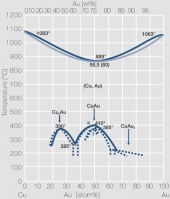Feinsilber
Feinsilber weist die höchste elektrische und thermische Leitfähigkeit aller
Metalle auf. Es ist resistent gegen Oxidbildung. Nachteilig wirken sich die
geringe Verschleißfestigkeit, niedrige Entfestigungstemperatur und vor allem die
hohe Affinität des Silbers gegen Schwefel und Schwefel-Verbindungen aus.
Durch Einwirkung schwefelhaltiger Verbindungen bilden sich bräunliche bis
schwarze Deckschichten aus Silbersulfid, die zu einer Erhöhung des Kontaktwiderstandes
und u.U. zum völligen Versagen des Schaltgerätes ...


